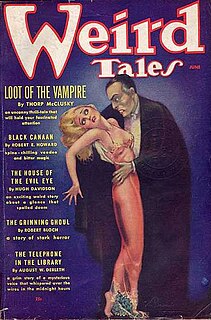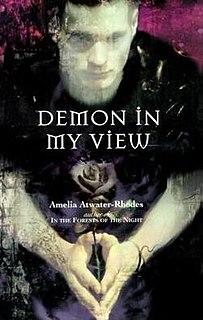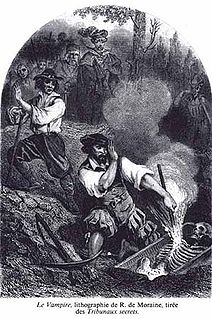Related Research Articles

A vampire is a creature from folklore that subsists by feeding on the vital essence of the living. In European folklore, vampires are undead creatures that often visited loved ones and caused mischief or deaths in the neighbourhoods they inhabited while they were alive. They wore shrouds and were often described as bloated and of ruddy or dark countenance, markedly different from today's gaunt, pale vampire which dates from the early 19th century.

Varney the Vampire; or, the Feast of Blood is a Victorian era serialized gothic horror story variously attributed to James Malcolm Rymer and Thomas Peckett Prest. It first appeared in 1845–1847 as a series of weekly cheap pamphlets of the kind then known as "penny dreadfuls". The author was paid by the typeset line, so when the story was published in book form in 1847, it was of epic length: the original edition ran to 876 double-columned pages and 232 chapters. Altogether it totals nearly 667,000 words.

Vampire literature covers the spectrum of literary work concerned principally with the subject of vampires. The literary vampire first appeared in 18th-century poetry, before becoming one of the stock figures of gothic fiction with the publication of Polidori's The Vampyre (1819), which was inspired by the life and legend of Lord Byron. Later influential works include the penny dreadful Varney the Vampire (1847); Sheridan Le Fanu's tale of a lesbian vampire, Carmilla (1872), and the most well known: Bram Stoker's Dracula (1897). Some authors created a more "sympathetic vampire", with Varney being the first, and Anne Rice's 1976 novel Interview with the Vampire as a more recent example.

The European dragon is a legendary creature in folklore and mythology among the overlapping cultures of Europe.

A gremlin is a mischievous folkloric creature that causes malfunctions in aircraft or other machinery. Depictions of these creatures vary. Often, they are described or depicted as animals with spiky backs; large, strange eyes; and small, clawed frames featuring sharp teeth.

The Nixie, Nixy, Nix, Näcken, Nicor, Nokk, or Nokken are humanoid, and often shapeshifting water spirits in Germanic mythology and of folklore.
In Balkans folklore, dhampirs are creatures that are the result of a union between a vampire and a mortal human. This union was usually between male vampires and female mortal humans, with stories of female vampires mating with male mortal humans being rare.

Vampires are frequently represented in popular culture, including appearances in ballet, films, literature, music, opera, theatre, paintings, and video games.
The Churel, also spelled as Charail, Churreyl, Chudail, Chudel, Chuṛail, Cuḍail or Cuḍel is a mythical or legendary creature resembling a woman, which may be a demoniacal revenant said to occur in South Asia and Southeast Asia, particularly popular in India, Bangladesh and Pakistan. The churel is typically described as "the ghost of an unpurified living thing", but because she is often said to latch on to trees, she is also called a tree-spirit. According to some legends, a woman who dies during childbirth or pregnancy or from suffering at the hands of her in-laws will come back as a revenant churel for revenge, particularly targeting the males in her family.
"That Vision Thing" is episode 2 of season 3 in the television show Angel. Written by Jeffrey Bell and directed by Bill L Norton, it was originally broadcast on October 1, 2001 on the WB network. In "That Vision Thing", Cordelia's vision gift grows dangerous when it begins physically affecting her. She is on the verge of death when Angel discovers Wolfram & Hart lawyer Lilah Morgan is sending the painful visions to force Angel to free a man imprisoned in an alternate dimension.

In the Forests of the Night is a vampire novel written by Amelia Atwater-Rhodes, and published in 1999. It was originally entitled White Wine. Atwater-Rhodes wrote it at the age of thirteen, but it was published on May 11, 1999, about a month after she turned fifteen. It is the first novel in the Den of Shadows series. It tells the story of a three-hundred-year-old vampire named Risika and her struggles throughout her life, both before and after she was turned into a vampire. The novel is told in first-person narrative by the protagonist, Risika. It was well-received by critics.
Perfect Creature is a 2007 New Zealand horror/thriller film from 2007, written and directed by Glenn Standring and starring Saffron Burrows and Dougray Scott, set in an alternate universe New Zealand. The New Zealand release date was 18 October 2007.

Demon in My View is a vampire novel written by Amelia Atwater-Rhodes, and published on May 9, 2000. Originally entitled Bitter Life, it was published when the author was 16. It is the follow-up to In the Forests of the Night, which she wrote at the age of 13. The title refers Edgar Allan Poe’s poem "Alone", which appears in the beginning of the book.

The Patasola or "one foot" is one of many myths in South American folklore about female monsters from the jungle, appearing to male hunters or loggers in the middle of the wilderness when they think about women. The Patasola appears in the form of a beautiful and seductive woman, often in the likeness of a loved one, who lures a man away from his companions deep into the jungle. There, the Patasola reveals her true, hideous appearance as a one-legged creature with ferocious vampire-like lust for human flesh and blood, attacking and devouring the flesh or sucking the blood of her victims.
The soucouyant or soucriant in Dominica, St. Lucian, Trinidadian, Guadeloupean folklore in Haiti, Louisiana, Grenada and elsewhere in the Caribbean or Ole-Higue in Guyana and Jamaica or Asema in Suriname), in The Bahamas and Barbados it is known as Hag. It is a kind of blood-sucking hag.

Legends of vampires have existed for millennia; cultures such as the Mesopotamians, Hebrews, ancient Greeks, and Romans had tales of demonic entities and blood-drinking spirits which are considered precursors to modern vampires. Despite the occurrence of vampire-like creatures in these ancient civilizations, the folklore for the entity we know today as the vampire originates almost exclusively from early 18th-century Southeastern Europe, particularly Transylvania as verbal traditions of many ethnic groups of the region were recorded and published. In most cases, vampires are revenants of evil beings, suicide victims, or witches, but can also be created by a malevolent spirit possessing a corpse or a living person being bitten by a vampire themselves. Belief in such legends became so rife that in some areas it caused mass hysteria and even public executions of people believed to be vampires.

Lost Tapes is an American television series that aired on Animal Planet. Produced by Go Go Luckey Entertainment, the program presents fictional found footage depicting traumatic encounters with creatures cryptozoological, supernatural, mythological or extraterrestrial. Creatures featured include Bigfoot, the chupacabra, vampires, werewolves, and reptilians.
References
- ↑ Harper, Charles G. Haunted Houses. Detroit: Tower Books, 1971. 288 pp.
- ↑ Hare, Augustine. Story of My Life. 6 vols. London: George Allen, 1896–1900.
- ↑ Melton, J. Gordon (1999). The Vampire Book, pp. 151–153.[ ISBN missing ]